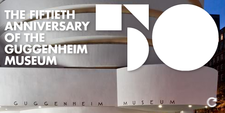 They were meant to be together so when I learned that the Guggenheim Museum was celebrating the 50th anniversary of its landmark building with an in-depth retrospective of the Russian avant-garde artist Wasilly Kandinsky, I knew I had to go.
They were meant to be together so when I learned that the Guggenheim Museum was celebrating the 50th anniversary of its landmark building with an in-depth retrospective of the Russian avant-garde artist Wasilly Kandinsky, I knew I had to go.
“The Angel in The Architecture,” trumpeted The New York Times headline for the review of the Guggenheim show, which runs through January 10. Frank Lloyd Wright designed the building especially for the museum’s founding collection of Kandinsky’s non-objective work.
I drove into New York City from Boston -- a tactic I do not recommend. And, speaking of angels, one must have been watching over me because I found a parking space within walking distance of the museum. Easy, right? Nope. I had a problem with the parking meter, a style that was new to me. Directions said it took credit cards, but when I slipped my Visa card into the slot and punched in the length of time I expected to be gone, nothing happened. I tried to remove my card from the slot to try again. The parking meter held the card in a vise-like grip.
A father with a curly-headed toddler in hand saw my predicament. He forcefully yanked my credit card from the machine and counted four quarters into my palm. “It’s easier with coins,” he said.
“Thanks,” I said, handing back his change. I certainly appreciated this random act of kindness, but I already had quarters.
“Keep it,” he insisted. “You may need it later.”
I thought about his kindess as I approached the Guggenheim. Sunshine poured goodwill upon an unseasonably warm, late fall day. The line of people waiting to get into the museum was long, yet no one shoved. No one tried to cut the line. Strangers chatted as amicably as small town neighbors.
Occasionally people in the line wandered over for a look at the amber jewelry and Russian folk art that street vendors displayed on folding tables by the curb. When they returned to their former place in the line, no one objected. Passersby stopped to eye the exotic offerings, too. Vendors answered questions graciously.
Inside, I admired the wondrous duet of Wright’s architecture and Kandinsky’s colorful art. Kandinsky (1866-1944) had been a representational artist. Monet and Wagner were his inspiration for turning to abstract art. The first time he encountered a Monet haystack painting, he recognized that the subject was not a haystack, but color and light. After hearing Wagner’s /Lohengrin/, he had an epiphany: literature, art, and music were a continuum. Music is emotional and abstract, and he ranked it as the highest art form. He wanted to capture those qualities in painting. The ramp up the spiral-shaped museum is a pathway to discovering the development of Kandinsky as a Modernist.
When the museum opened, critics were not kind to Wright or to the Guggenheim. They groused about the tilted, spiral-shaped building with walls that curved; they said it would never work to display paintings. Besides, the structure disrupted the traditional New York City streetscape. Time has proved the naysayers wrong. The Guggenheim is now an integral and familiar feature of the city. It is not only of the city’s most popular attractions, but Wright’s masterpiece.
After the museum, I waited anxiously on a Broadway street corner to meet my husband; It was almost an hour past the agreed upon time. I’d left my cell phone in the car and hesitated to go back for it. I might miss him. But what if something had happened? I needed to reach him.
Two men passed, one speaking on a cell phone. He snapped his phone shut and slipped it into his pocket. “Excuse me,” I ventured. They stopped. I took a step towards them. “May I use your phone?” I asked, explaining my dilemma.
The man handed it to me. It was an ultra compact model with many features and numbers too small for me to see clearly. “Would you mind dialing?” I inquired sheepishly.
He tapped in the number. Within seconds I heard my husband’s voice. He was waiting at a nearby corner, calling me every few minutes and growing nervous because I didn’t answer my phone. He would be right over. I thanked the stranger.
“I’m glad everything’s all right,” he said.
Time has mellowed New Yorkers. Whether it was the horrific, shared experience of 9/11, I do not know, but whatever caused it, New Yorkers are different, friendlier. In fact, they’ve changed so much that they’re in danger of losing their time-honored reputation for being abrasive, pushy, rude, and snobbish.
Boston-based, freelance writer Shirley Moskow left daily journalism for the life of a footloose freelancer. She often writes about art and travel.

